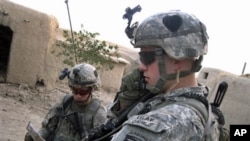The U.S.-led war in Afghanistan has now entered its 10th year and President Barack Obama is hoping that next July will mark the beginning of its end. That is when, under the administration's Afghan strategy, U.S. troops are scheduled to begin withdrawing from the country.
But the condition always attached to the withdrawal plan is, "conditions permitting." And with less than one year to go before that target date, analysts say getting favorable conditions to begin a troop drawdown will be tough.
The United States wants to get the Afghan army and police trained to the point that they can take over security duties. It also seeks to "degrade" the Taliban to the point that it is no longer a threat. Washington is pushing the government of President Hamid Karzai to clean up corruption. And it also wants Pakistan to clear out the Taliban and al-Qaida sanctuaries in the Federally Administered Tribal Areas [FATA] along its border with Afghanistan.
"You can't say a bunch more [Afghan-trained] forces, more counterinsurgency, more accountability [by the Afghan government], and do it all in a period of less than a year," says U.S. Army War College professor Larry Goodson. "Everybody knows that is an impossible task."
The tactical situation in Afghanistan has changed greatly since the war began in October, 2001.
The Taliban, who were reeling after being dislodged from Kabul in 2001, have regrouped, and are fighting a different kind of war then they did before. They do not have to engage in direct and protracted combat actions. They can plant hidden and lethal improvised explosive devices -- a tactic learned from the Iraq insurgency -- in a road or path to explode and inflict casualties. Suicide bombers are another new weapon usable any time, even in the brutal Afghan winter.
Politically, the landscape also is different. Hamid Karzai, chosen in 2001 by the international Bonn Conference to lead a post-Taliban Afghanistan, has since won two presidential elections. But the elections have been marred by allegations of fraud, and U.S. officials have complained publicly about what they see as the government's rampant corruption.
"You can kill and kill and kill," said Georgetown University professor Christine Fair. "But without a reliable partner, counterinsurgency cannot succeed."
Pakistan, where many of the insurgents are based, has gone from military rule back to an elected government. But the military there still wields considerable power. A report from the U.S. National Security Council says that in the April to June period, the Pakistan military continued to avoid military engagements that would put it in direct conflict with Afghan Taliban or al-Qaida forces in the North Waziristan region.
"This is as much a political choice as it is a reflection of an under-resourced military prioritizing its targets," said the report, which was compiled by the National Security Council for Congress.
And Washington also remains worried about Pakistan's Inter-Services Intelligence agency [ISI]. A Pentagon spokesman, Col. David Lapan, told reporters Thursday that the U.S. officials are concerned that "elements of the ISI might be interacting with terrorist organizations in ways that aren't consistent with what the government and the military are doing."
Analysts say Pakistan is still trying to gain influence in Afghanistan for fear that archrival India will beat them to it when American troops leave.
"The Pakistanis are playing the same old game," said Georgetown University's Christine Fair. She said a U.S. exit will not be possible without addressing the issue of Taliban and al-Qaida sanctuaries in Pakistan, which, she added, accounts for the stepped-up pace of U.S. aerial drone strikes in the tribal areas near the border and even some controversial U.S. "hot pursuit" incursions deeper into Pakistani territory.
The Pakistan government, angered by the cross-border strikes, choked off the main military supply route to Afghanistan by shutting the border at the base of the Khyber Pass, leaving hundreds of trucks stranded, stationary, and vulnerable to attack.
So what conditions will permit a U.S. drawdown?
Expressing his own view, the Army War College's Larry Goodson, who has wide experience in Afghanistan and Pakistan, believes it will be a case of lowered expectations.
"'Conditions permitting' sounds wonderful but it really depends on the interpretation of the person making that judgment," he said. "I think they're going to begin to make the argument that we have achieved primary ends and that the conditions are not perfect for withdrawal, but are for a change of mission. It will be an awkward case of declaring victory knowing that the mission is unfinished, but saying also that we need a robust counter-terrorism presence and we will draw forces down into training mission."
Meanwhile, reports have emerged of at least preliminary talks between the Karzai government and the Taliban. Goodson says President Karzai is trying to ensure his survival after the U.S. leaves, and that talks are a signal to Washington not to hasten its withdrawal.
Gary Thomas is VOA's Senior News Analyst.












